F9F-8T / TF-9J Cougar / Twogar
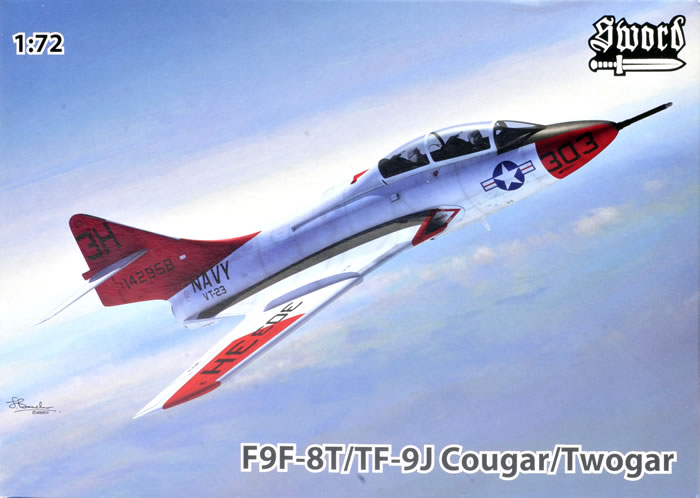
Sword, 1/72 scale
S u m m a r y : |
Catalogue Number: |
Sword Kit No. SW72093 – F9F-8T / TF-9J Cougar / Twogar |
Scale: |
1/72 |
Contents & Media: |
Fifty-eight grey and six clear styrene parts, two resin seats, and decals for three subjects. |
Price: |
Available on-line from these stockists:
Click here for currency conversion. |
Review Type: |
First Look. |
Advantages: |
The only complete kit in 1/72 scale of the two-seat Cougar, nice detail, accurate appearance, good value too. |
Disadvantages: |
Bland resin ejection seats that lack harness detail. |
Conclusions: |
This is a good kit of significant and appealing Cougar derivative. I applaud Sword for releasing it, and for their new-style instructions with a much-improved colours & markings guide.
The slight letdown is that Sword has provided better cockpit detail in the past, particularly ejection seats. The kit’s very visible seats are obviously designed to have PE harnesses but did not get them. If instead they had harness detail cast integrally all would be fine, but they do not. I think most would accept paying a bit more to have the same standard of cockpit detail as their Photo-Cougar kit. Sword has set a benchmark with previous releases; so I think they should at least be consistent and maintain it.
However, since Sword has given us a good affordable kit of the Twogar all is forgiven! I highly recommend it. |
Reviewed by
Mark Davies

Sword's 1/72 scale F2H-2N Banshee is available online from
Squadron.com
The Grumman F9F/F-9 Cougar was a carrier-based fighter aircraft for the United States Navy. Based on Grumman's earlier F9F Panther, the Cougar replaced the Panther's straight wing with a more modern swept wing. The Navy considered the Cougar an updated version of the Panther, despite having a different official name, and thus Cougars started from F9F-6 upward.
Initial production (646 airframes) was the F9F-6, delivered from mid-1952 through July 1954. The F9F-6 first flew on September 20, 1951; seven months after Grumman signed a contract with the Navy for swept-wing fighter.
The F9F-7 referred to the next batch of Cougars that were given the Allison J33 also found in the F9F-4, instead of the Pratt & Whitney J48. One hundred sixty-eight were built, but the J33 proved both less powerful and less reliable than the J48. Almost all were converted to take J48s, and were thus indistinguishable from F9F-6s. These were redesignated F-9H in 1962.
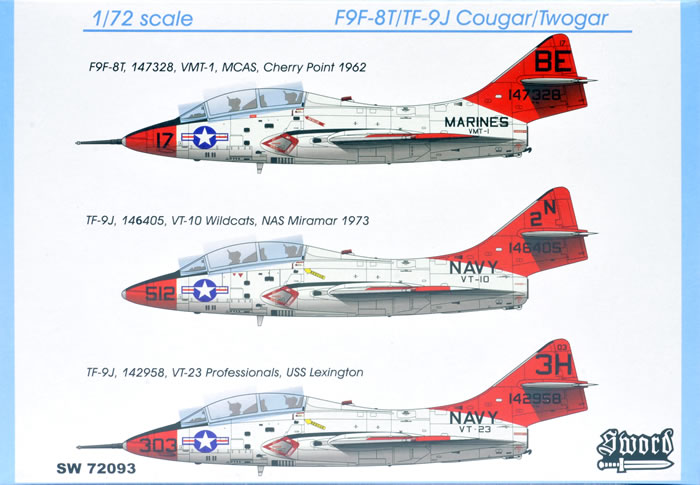
Work on the F9F-8 began in April 1953 with three goals: lower the planes stall speed, improve aircraft control at high angles of attack, and increase range. It featured an 8 in (20 cm) stretch in the fuselage and modified wings with greater chord and wing area (from 300 to 337 square feet), to improve low-speed, high angle of attack flying and to give more room for fuel tanks. Because of the wing changes, top speed was increased to 704 mph and minimum catapult speed was lowered to 127 knots (146 mph). It also was now capable of breaking the sound barrier in a steep dive.
The Navy acquired 377 two-seat F9F-8T trainers between 1956 and 1960. They were used for advanced training, weapons training and carrier training, and served until 1974. They were armed with twin 20 mm (.79 in) cannon and could carry a full bombs or missiles load. In the 1962 redesignation, these were called TF-9J.
The only version of the Cougar to see combat was the TF-9J trainer (until 1962, F9F-8T). Detachments of four Cougars served with US Marines Headquarters and Maintenance Squadron 11 (H&MS-11) at Da Nang and H&MS-13 at Chu Lai, where they were used for fast-Forward Air Control and the airborne command role, directing airstrikes against enemy positions in South Vietnam between 1966 and 1968.
The TF-9J had a long service with the U.S. Navy, but the proposed Cougar modification (re-engined with a J52 engine) was rejected, and the Navy selected the TA-4F Skyhawk. The last Cougar was phased out when VT-4 re-equipped on February 1974.
Source: Wikipedia
Previous 1/72 Scale F9F-8T/TF-9J Kits
Aside from Airmodel’s crude vac-form F9F-8/8P/8T there has not previously been a 2-seat Cougar kit in “The One True Scale” as far as I am aware.
There were until now three other paths to obtaining a 1/72 scale Twogar. RVHP and Esoteric both released resin conversions, and Falcon a vac-form conversion (part of a triple conversion that also covered the F-106B and Mirage IIID). Of course, converting the Hasegawa kit with the forward fuselage from Airmodel kit was also possible, although scratch building almost seems better than this option!
Sword’s new kit clearly fills an important gap for builders of USN and USMC jets.
Contents
The kit comes in an end-opening box with digital artwork on the front and colour profiles of the markings options on the rear.
The decals, plastic and resin parts come in a zip-lock bag, with the clear parts further enclosed in a small bag of their own.
The Instructions
This kit has new style instructions for Sword. These are an A4 sized stapled booklet printed in colour on matte finish paper. They are notable for their very large and clear assembly illustrations, and new full-colour four-view colours and markings drawings. Sword has always provided good clear assembly drawings, but these were printed on paper half the size with a monochrome colours & markings section with generic colour descriptions. The big improvement is the large colour-printed colours & markings section and the inclusion of FS.595 colour codes for the airframe colours. Generic paint names are used for detail painting, and given in Czech and English, whilst all other text in English.
The Kit
This is a typical Sword kit with nicely moulded parts, fine surface detail, and reasonably narrow sprue gates. There is a tiny hint of flash in places, but this is very easy to deal with. There are also quite a few prominent ejector stubs, fortunately in areas that cannot be seen. Some will require removal in order for parts to fit correctly; but again, this is easily done. Parts break down is conventional for the type. The canopy parts are clear and acceptably thin.
Sword’s F9F-8P Photo-Cougar (reviewed by me here on HyperScale a year ago) had very nice cockpit detail with PE providing the instrument panel, side consoles, seatbelts for the resin seat, throttle and other levers, and a canopy handle. I had similar expectations with this kit, but was disappointed to find an all-styrene cockpit with two resin ejector seats devoid of harnesses and firing handles. Seats aside, the detail is okay, but Sword has offered much better on several of their single seat kits.
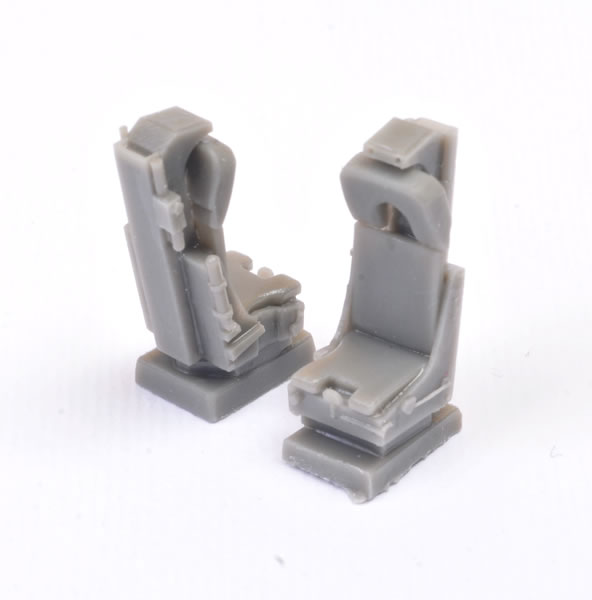
The Martin Baker A5 ejection seats really are a let-down, and I am sure modellers would happily pay a bit more to have had similar PE details as offered with the F9F-8P kit; or just better mastered resin seats that include harness detail, after all, resin production costs would be the same as for the two bland seats provided.
The instructions advise to paint the cockpit sidewall black, yet in Steve Ginter’s Two-Seat Cougars (Naval Fighters #68); they appear to be a light grey. I have read elsewhere that this should be dark gull grey, which is apparently the standard USN cockpit interior colour that replaced black in the early 1950’s (although the internal canopy framing should still be black). The instructions would also have you paint the seat frames light grey, although my checking indicates that Martin Baker’s standard black finish applies here.
The surface detail is nicely done using fine engraved panel lines. A clever touch is the inclusion of six plates that fit within the fuselage halves around the opening for the lower wing/fuselage belly. These serve to firmly support and correctly align the belly and lower wings with the fuselage in a way that the two-part limited run moulds could not readily cater for, so well done Sword!
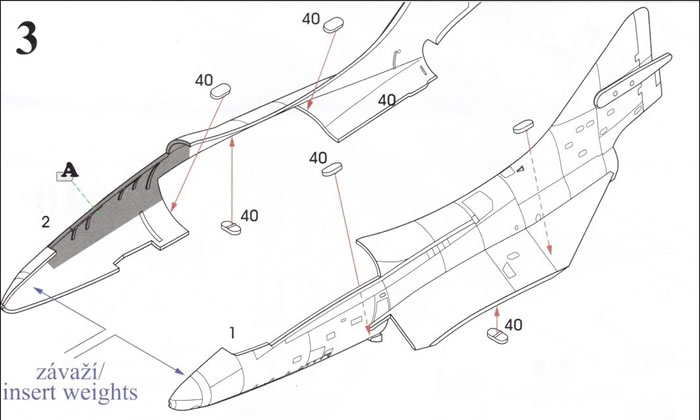
Internal detail within the wheel wells is adequate, and little will be visible anyway. The main undercarriage legs have solid torque-links that are quite reasonable, whilst the wing fences will benefit from a little thing down (Sword’s F9F-8P kit has finer PE torque link and wing fences). A turbine face and length of jet pipe are provided for the rear fuselage, and the air-intake ducting is nicely represented with plenty of depth going back into the wing roots.
The clear parts are well done, and aside from the two-piece canopy, include the blast screen between the two seats, a wing root landing light, and wingtip navigation lights.
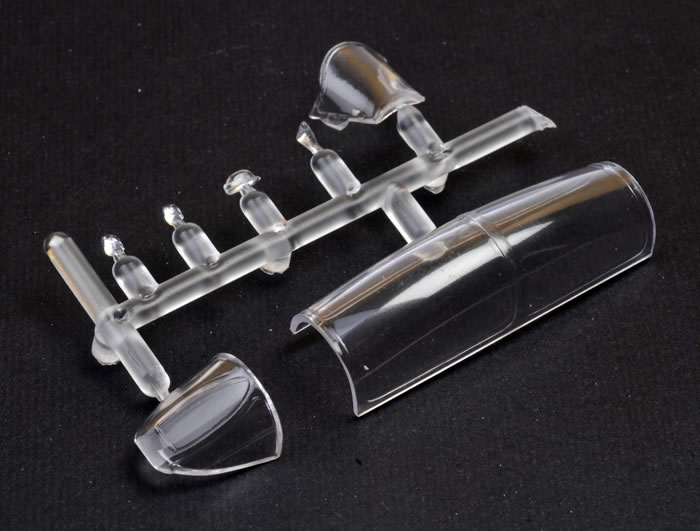
The parts map shows an alternative vac-form canopy (to show off all that missing PE detail I wonder?), but is not provided. Other reviews have noted the same thing, so it was not a missing part from just my review sample.
The kit includes the two inboard stores pylons (although without sway-braces) but not the two outboard ones. All are removable on the real plane, so this is not wrong; but it would have been nice to have all six plus some stores, say drop-tanks at least. There just remain a few small details to add, along with a nose mounted refuelling probe for two of the markings options. The mounting hole in the nose will need filling for the option sans-probe.
Overall, I should think that this kit should be an enjoyable one to build, provided you accept that its limited-run nature may demand some fettling here and there.
Marking Options
Techmod prints the decals, and these are well registered with what appears to be good opacity. I am sure they will prove to be excellent to apply based on my experience of this brand.

The instructions provide three full colour pages of four-view drawings with the national insignia and unit markings for each of the three schemes offered, and include stencil locations. These include FS.595 codes for airframe colours and are a big improvement on Sword’s previous monochrome colours & markings guides.
The subjects covered are illustrated in the Introduction section.
This is a good kit of significant and appealing Cougar derivative. I applaud Sword for releasing it, and for their new-style instructions with a much-improved colours & markings guide.
The slight letdown is that Sword has provided better cockpit detail in the past, particularly ejection seats. The kit’s very visible seats are obviously designed to have PE harnesses but did not get them. If instead they had harness detail cast integrally all would be fine, but they do not. I think most would accept paying a bit more to have the same standard of cockpit detail as their Photo-Cougar kit. Sword has set a benchmark with previous releases; so I think they should at least be consistent and maintain it.
However, since Sword has given us a good affordable kit of the Twogar all is forgiven! I highly recommend it.
Thanks to Sword Models for this review sample.
Review Text Copyright © 2016 by Mark Davies
Images Copyright © 2016 by Brett Green
Page Created 4 July, 2016
Last updated
4 July, 2016
Back to HyperScale Main Page

|
